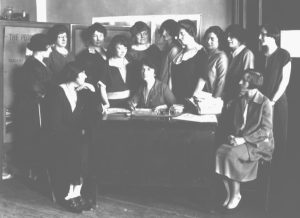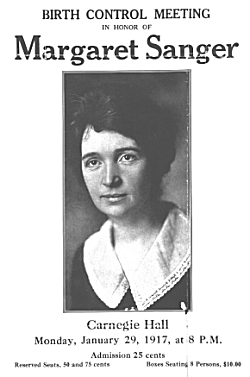
The Record - September 1998
Documentary Editing and Publishing
Timothy Connely, Editor
Documentary Editors on the World Wide Web: The Margaret Sanger Papers
by Cathy Moran Hajo
The World Wide Web has rapidly become the first place that people look when they are interested in a topic. For those with access, Internet searches can rapidly open a door to a vast storehouse of knowledge and information. Everyone seems to have a Web page, whether for doing business, advertising a conference, or just telling the world who they are. Wading through this virtual forest to find specific material can occupy hours, even days with no guarantee that the information found on the Web is accurate or complete.

Margaret Sanger, seated, surrounded by staff members of the American Birth Control League, ca. 1921. (Library of Congress)
Everyone thinks you need a "presence" on the Web or expects that you already have a Web site. There are many good reasons for documentary editors to create a web site, but it takes time and careful thought to create the type of site that best suits your needs.
Perhaps the key to any successful web site is knowing your audience. By thinking about the kinds of users you are trying to reach with your project, finding ways to attract them becomes far less daunting. Audiences for documentary editing projects are made up of many groups: scholarly researchers who search the Web and may use editions for lengthy or in-depth studies; college students who often write shorter papers and do not explore subjects in as much depth; high school and grammar school users who use web sites as one might an encyclopedia article; funders who may visit a site while reviewing proposals; the press; and the general public.
A Web site, like any other publication, requires careful planning. Once you decide who you want to reach, you can begin to decide upon the elements to include. Most editing projects share these goals for Web sites: attracting attention to the project; positioning the project as a clearinghouse for accurate information; providing direct access to transcribed documents on the Web; advertising the project's publications; and saving reference time. Individual projects will have varying combinations of these and perhaps additional goals, and may rank them differently. Thus Web sites often take on unique configurations as projects use them to accomplish specific goals and reach their targeted audiences.
A case in point is the Margaret Sanger Papers Project (MSPP). Editing the papers of the controversial birth control reformer offers unique challenges and opportunities. In the face of the stormy debate over reproductive rights for women, our aim is to provide wide access and historical context to Margaret Sanger's words. To this end, the MSPP staff has organized, indexed and microfilmed more than 50,000 letters, speeches, diaries, and other manuscript material and published the documents as The Margaret Sanger Papers Microfilm Edition: The Smith College Collections (University Publications of America, 1995) and Collected Documents (University Publications of America, 1997). The MSPP is currently working on a three-volume book edition to be published by Indiana University Press. These volumes will contain selected letters, diaries, speeches, and writings which we are transcribing and annotating. The project is also finishing up work on an item-level index to a microfilm publication of Sanger's papers housed at the Library of Congress.
When we began to design our Web site, we had three major priorities. The first was simply to make people aware of the project and its publications. To that end, we included descriptions of our microfilm editions, linked to electronic versions of our reel guides (mounted on our publisher's Web site), listed libraries that own the microfilm edition and/or guide, and provided descriptions of the book and electronic editions. We made it easy for visitors to contact MSPP staff via e-mail.
A second goal was to reduce the time that we were spending answering research queries. While we are always pleased to help researchers, many of the questions we received are very general. Younger researchers often asked for the most basic biographical data about Margaret Sanger and had rarely consulted any other reference sources before approaching us. Other researchers requested "everything" on Margaret Sanger or copies of all her speeches (they fill twelve reels of microfilm), or only the "important" ones. And we found ourselves repeatedly answering these same general questions.
Based on these goals we decided to create a Web site that contains: a bibliography of primary and secondary sources on Sanger and the birth control movement (including a separate list for younger readers and citations to major encyclopedia articles); links to reputable electronic versions of Sanger's writings on the Internet; a biographical sketch of Sanger; selected articles from our newsletter; links to related women's history, population, and reproductive rights Web sites; and brief histories, drawn from our microfilm guide, of birth- control organizations founded or led by Margaret Sanger. Having all of this material on the Web site provides sufficient information to answer the needs of most of our general users. Of course, the project still receives and answers a large number of inquiries, but we can now refer many researchers to relevant reference pages on the Web site. This permits us to spend more of our limited time helping those researchers with more detailed questions.
The third goal of the MSPP Web site is to serve as a corrective to much of the material already published on the World Wide Web about Margaret Sanger. Like many editing projects we find that some reference sites on the Internet (even some that come with impressive pedigrees) perpetuate simplistic or even inaccurate information on our subject. Because of her controversial nature, however, Web sites on Margaret Sanger often go beyond simple errors or sloppy research. Many of these sites have been mounted by those with a stake in the current debate over abortion and reproductive rights, rather than by historians or scholars. Sites that represent the views of the anti-choice movement often mount attacks on Sanger based on inaccurate renderings of text and context, misquotations, or deliberate misreadings of Sanger's words to further their current agendas. To be fair, we also found a few pro-choice sites which, out of a wish to defend Sanger, also misrepresent her positions.
These sites can have a serious impact on student researchers. As one high school student e-mailed us: "I haven't done much of my research on Sanger yet, but I do have one question. I came across some really gross writings about her on the Internet. They said she was a racist, a Nazi, etc. I don't really think these things are true. But to be fair, I need to check them out. So, was she?"

Flyer from benefit held on eve of Sanger's trial for opening Brownsville Clinic. (Courtesy of Sanger Project)
Before we launched our site little was available on the web to refute these distorted views of Sanger and the birth control movement. The need for a scholarly source with accurate, verified material on Margaret Sanger was therefore compelling. Thus, a major goal of our web site is to make accurate information on Sanger at least as readily available as the inaccurate or biased material.
The MSPP Web site includes a transcribed and annotated sample document from the book edition. We are also working with the Model Editions Partnership, a project sponsored by the NHPRC, to create and investigate models for providing electronic access to scholarly documentary editions. Once the partnership has completed its work later this year, we will link the electronic sample we produced to the project's web site.
The Margaret Sanger Papers Project's Web site has been operational at http://www.nyu.edu/projects/sanger/ since May of 1997. In that time it has been visited more than 8,700 times. Our analysis of visits to the site's pages shows that researchers are using it much as we hoped they would. Among the most frequently used pages are the general reference aids: the biographical sketch, bibliography, organizational histories, and newsletter articles. The Web site has provided a first step into scholarly electronic access to Sanger, and it is one that we expect to enhance over time with the addition of our Model Editions Partnership sample and other online mini-editions.
The experiences of the MSPP in developing a Web site are mirrored by many other documentary editing projects. Web sites have allowed editors greater access to their public and have enabled us to inform more people about our work and the subjects we document. In so doing, they help to promote the use of primary sources by a broad and growing audience.
Cathy Moran Hajo is Associate Editor of The Margaret Sanger Papers at New York University.